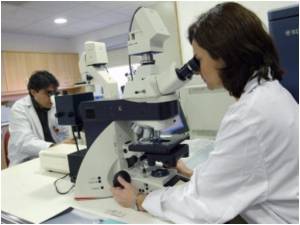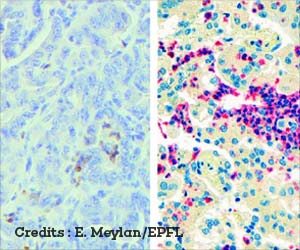HET0016, a chemical inhibitor enzyme can help limit the growth of brain tumor and metastatic breast cancer by deactivating a chemical that promotes cancer.

‘HET0016, the inhibitor of 20-HETE was able to decrease the amount of growth factors responsible for the aggressiveness and invasiveness of the tumor cells significantly.’





"Our idea is that the most aggressive tumors have the same basic mechanisms of growth and spread," says senior author on separate review articles on both the deadly cancers in the International Journal of Molecular Sciences. "We have good evidence that blocking 20-HETE production is a good way to inhibit that growth." again says Arbab, the senior author of the study.20-HETE is an essential partner for our healthy body and apparently for cancer as well. 20-HETE, or 20-Hydroxyeicosatetraenoic acid, is a metabolite of arachidonic acid, a fatty acid we make and constantly use for a wide variety of functions like helping make lipids for our cell membranes.
20-HETE's normal functions include helping regulate blood pressure and blood flow. It's also a known mediator of inflammation, which under healthy conditions can help us fight infection and actually protect us from cancer and other invaders.
But tumors express too much 20-HETE, and the chemical turns on us, first by activating immune cells that will send the cytokines that become the siren call to our bone marrow, says Dr. B.R. Achyut, cancer biologist in the MCG Department of Biochemistry and Molecular Biology and corresponding author of the paper on glioblastoma.
Once the bone marrow cells show up, 20-HETE also turns the cells' usually lifesaving functions, like making blood vessels and populating our immune system, against us, Achyut says. This includes bolstering the primary tumor site and in the case of breast cancer, helping prepare remote sites in places like the brain, lung, and liver, he says.
Advertisement
20-HETE also activates signaling kinases that enable cell division. It encourages inflammation-promoting factors like tumor necrosis factor alpha and several of the interleukins, another class of proteins that help regulate the immune response.
Advertisement
To reduce the many ill effects of too much 20-HETE, the scientists have used an inhibitor, called HET0016, in combination with chemotherapy, says Dr. Thaiz F. Borin, a molecular biologist in the MCG Department of Biochemistry and Molecular Biology and corresponding author of the paper on breast cancer metastasis. They expect its clinical usage also will be as an adjuvant therapy.
They have given the drug alternately with the chemotherapy drug temozolomide for three to six weeks. They have found in rats with glioblastoma; for example, the rodents survived for at least six months - at which time they were euthanized as part of the study - instead of for only a few weeks as likely would have been the case.
Like many ironies of cancer, hypoxia, a lack of adequate blood and oxygen often associated with disease and death, seems to be a survival tactic for both these rapidly growing tumor types.
When a glioblastoma reaches the diameter of just .1 inch, for example, the rapid growth and cell division make the center of this very vascular tumor hypoxic, the scientists say. That leads to the need to recruit from the bone marrow a myriad of factors like vascular endothelial growth factor, or VEGF, that enable blood vessel and tumor growth, which the misguided 20-HETE enables.
The bone marrow cells the tumor cytokines also include endothelial progenitor cells to make the lining of all the new blood vessels that VEGF and myeloid cells are making. Myeloid cells are immature, multitasking cells that can drive protective inflammation, but in this case, help tumors suppress the usual immune response in addition to making blood vessels.
Increased numbers of these myeloid-derived suppressor cells, or MDSCs, are recruited to both the main tumor and its metastatic sites. Higher rates of these cells are associated with higher rates of recurrence and metastasis.
One of the team's many findings is that targeting the arachidonic acid pathway by inhibiting the production of 20-HETE resulted in a reduction of MDSCs in the usual sites of breast cancer spread like the lungs, liver, brain or bones.
There was less communication between the tumor's base camp and these deadly satellite locations. When they examined the lungs, they saw fewer cytokines to summon the bone marrow cells and fewer enzymes that also support invasiveness of the breast cancer cells.
HET0016, the inhibitor of 20-HETE, also was able to decrease the amount of growth factors, cytokines and enzymes called metalloproteinases responsible for the aggressiveness and invasiveness of the tumor cells, Borin says.
The primary tumors also shrank because they are no longer recruiting the factors that enable growth, Arbab says. "They are becoming static," he adds, noting that the 20-HETE blocker does not kill tumor cells, rather essentially puts them on hold.
The Georgia Cancer Center team notes that chemotherapy does kill tumor cells, but when the tumors start dying they actually increase their release of cytokines as another cry for survival, which is another good reason to also directly target the call for assistance that tumors are sending, Arbab says.
"Cytokines are the point of action, and cancer releases a lot of them," Borin says of these molecules well known for their role in regulating the immune response. The 20-HETE inhibitor they are using for the preclinical studies is made by Dr. Iryna Lebedeva, assistant professor in the Department of Chemistry and Physics at Augusta University. The scientists already have identified companies that could make a clinical grade inhibitor. To date, they have studied only one dose of the research drug, and Arbab has submitted a grant to the National Cancer Institute to look at escalating doses in the rat model of glioblastoma.
They are also working now to learn more about how the inhibitor works, including its impact on the tumor microenvironment, and more about what happens to the bone marrow cells that tumors recruit.
While a 20-HETE inhibitor has not yet been used in humans, commonly used drugs like aspirin and Celebrex, which target other arachidonic acid pathways, are widely used. The scientists' studies indicate that healthy bone marrow production is untouched by 20-HETE inhibition because it's blocking the tumor's signals not the bone marrow directly. And nobody wants bone marrow cells once tumors get their attention, they note. "They are working for the tumor," Borin says.
Adjuvant therapies that directly target the tumor microenvironment - several of which are currently in clinical trials - are a promising approach for both new and recurrent glioblastoma's, the researchers write, along with those that target 20-HETE. More labs with a focus on glioblastomas could also help move science to the bedside faster, they say.
The researchers even suggest pursuing drugs that could normalize blood vessel production, reducing the recurring hypoxia and the tumor's cue to grow.
Unlike breast cancer, glioblastoma typically does not spread to other organs rather increasingly occupies more and more space that should be occupied by the healthy brain. Patients can die from the pressure the tumor puts on the brain.
Source-Eurekalert















